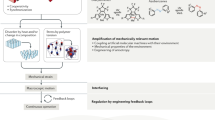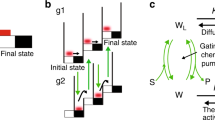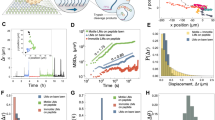Abstract
Methods for manipulating single molecules are yielding new information about both the forces that hold biomolecules together and the mechanics of molecular motors. We describe here the physical principles behind these methods, and discuss their capabilities and current limitations.
Key Points
-
Methods for manipulating single molecules are yielding new information about both the forces that hold biomolecules together and the mechanics of molecular motors.
-
All single-molecule manipulation methods require two basic elements: a probe, which is usually of microscopic dimensions, that can generate or detect forces and displacements; and a way to spatially locate the molecules.
-
Mechanical force transducers apply or sense forces through the displacement of a bendable beam. The most common examples are SFM cantilevers and microneedles.
-
The advantages of SFM are its high spatial range and sensitivity, its throughput (the ability to study many single molecules on a surface) and versatility.
-
Glass microneedles are usually softer than SFM cantilevers, giving them an advantage for probing delicate biological systems.
-
Unlike mechanical transducers, external fields act on molecules from a distance. These fields can be used to exert forces on molecules by acting either on the molecules themselves, or through 'handles' such as glass beads, polystyrene beads or metallic particles attached to the molecules.
-
Flow fields exert forces on objects through the transfer of momentum from the fluid to the object.
-
Magnetic fields can be used to manipulate and apply very stable and small forces to biomolecules that are tethered to magnetic particles.
-
Optical tweezers use radiation pressure (which stems from the momentum change as light refracts off an object) to hold objects in a focused laser beam, with which it is possible to generate a spring-like force.
-
The future of biomolecular manipulation depends on three factors: the integration and further development of single molecule techniques, progress in the field of nanotechnology, and the use of high-throughput systems such as microfluidics (microscopic liquid channels).
This is a preview of subscription content, access via your institution
Access options
Subscribe to this journal
Receive 12 print issues and online access
$189.00 per year
only $15.75 per issue
Buy this article
- Purchase on Springer Link
- Instant access to full article PDF
Prices may be subject to local taxes which are calculated during checkout




Similar content being viewed by others
References
Bustamante, C., Smith, S., Liphardt, J. & Smith, D. Single-molecule studies of DNA mechanics. Curr. Opin. Struct. Biol. 10, 279?285 (2000).
Svoboda, K. & Block, S. M. Biological applications of optical forces. Annu. Rev. Biophys. Biomol. Struct. 23, 247?285 (1994).
Ludwig, M. et al. AFM, a tool for single-molecule experiments. Appl. Phys. Mater. Sci. Process. 68, 173? 176 (1999).
Mehta, A. D., Rief, M. & Spudich, J. A. Biomechanics, one molecule at a time. J. Biol. Chem. 274, 14517?14520 (1999).
Sarid, D. in Scanning Force Microscopy: With Applications to Electric, Magnetic, and Atomic Forces I?XI, 253 (Oxford Univ. Press, New York, 1991).
Carrion-Vazquez, M. et al. Mechanical and chemical unfolding of a single protein: a comparison . Proc. Natl Acad. Sci. USA 96, 3694? 3699 (1999).
Bustamante, C., Marko, J. F., Siggia, E. D. & Smith, S. Entropic elasticity of lambda-phage DNA. Science 265 , 1599?1600 (1994).
Smith, S. B., Finzi, L. & Bustamante, C. Direct mechanical measurements of the elasticity of single DNA molecules by using magnetic beads. Science 258, 1122?1126 (1992). This first single-molecule study of DNA elasticity demonstrates the combined use of magnetic and flow fields.
Marko, J. F. & Siggia, E. D. Stretching DNA. Macromolecules 28, 8759?8770 ( 1995).
Erie, D. A., Yang, G., Schultz, H. C. & Bustamante, C. DNA bending by Cro protein in specific and nonspecific complexes: implications for protein site recognition and specificity. Science 266, 1562?1566 (1994).
Wuite, G. J., Smith, S. B., Young, M., Keller, D. & Bustamante, C. Single-molecule studies of the effect of template tension on T7 DNA polymerase activity. Nature 404, 103?106 (2000).
Kishino, A. & Yanagida, T. Force measurements by micromanipulation of a single actin filament by glass needles. Nature 334, 74?76 (1988). The basic premise of microneedle manipulation is illustrated here in one of the earliest measurements of the force from biological molecules using a mechanical transducer.
Svoboda, K., Schmidt, C. F., Schnapp, B. J. & Block, S. M. Direct observation of kinesin stepping by optical trapping interferometry . Nature 365, 721?727 (1993).
Howard, J., Hudspeth, A. J. & Vale, R. D. Movement of microtubules by single kinesin molecules . Nature 342, 154?158 (1989).
Ishijima, A., Doi, T., Sakurada, K. & Yanagida, T. Sub-piconewton force fluctuations of actomyosin in vitro. Nature 352, 301?306 (1991).
Nakajima, H. et al. Scanning force microscopy of the interaction events between a single molecule of heavy meromyosin and actin. Biochem. Biophys. Res. Commun. 234, 178?182 (1997).
Rotsch, C., Jacobson, K. & Radmacher, M. Dimensional and mechanical dynamics of active and stable edges in motile fibroblasts investigated by using atomic force microscopy . Proc. Natl Acad. Sci. USA 96, 921? 926 (1999).
Viani, M. B. et al. Small cantilevers for force spectroscopy of single molecules . J. Appl. Phys. 86, 2258? 2262 (1999).
Müller, D. J., Baumeister, W. & Engel, A. Controlled unzipping of a bacterial surface layer with atomic force microscopy. Proc. Natl Acad. Sci. USA 96, 13170?13174 (1999).
Oesterhelt, F. et al. Unfolding pathways of individual bacteriorhodopsins. Science 288, 143?146 ( 2000).In this study of a membrane protein, the authors present an elegant example of combining force and imaging SFM.
Finer, J. T., Simmons, R. M. & Spudich, J. A. Single myosin molecule mechanics: piconewton forces and nanometre steps. Nature 368, 113? 119 (1994).
Thomson, N.H. et al. Protein tracking and detection of protein motion using atomic force microscopy. Biophys. J. 70, 2421? 2431 (1996).
Almqvist, N. et al. Methods for fabricating and characterizing a new generation of biomimetic materials. Mater. Sci. Eng. C 7, 37?43 (1999).
Viani, M. B. et al. Fast imaging and fast force spectroscopy of single biopolymers with a new atomic force microscope designed for small cantilevers. Rev. Sci. Instrum. 70, 4300?4303 (1999).
Kitamura, K., Tokunaga, M., Iwane, A. H. & Yanagida, T. A single myosin head moves along an actin filament with regular steps of 5.3 nanometres. Nature 397, 129? 134 (1999).
Kellermayer, M. S. & Granzier, H. L. Elastic properties of single titin molecules made visible through fluorescent F-actin binding . Biochem. Biophys. Res. Commun. 221, 491 ?497 (1996).
Ishijima, A. et al. Multiple- and single-molecule analysis of the actomyosin motor by nanometer-piconewton manipulation with a microneedle: unitary steps and forces. Biophys. J. 70, 383? 400 (1996).
Essevaz-Roulet, B., Bockelmann, U. & Heslot, F. Mechanical separation of the complementary strands of DNA. Proc. Natl Acad. Sci USA 94, 11935? 11940 (1997).
Cluzel, P. et al. DNA: an extensible molecule. Science 271, 792?794 (1996).
Leger, J. F., Robert, J., Bourdieu, L., Chatenay, D. & Marko, J. F. RecA binding to a single double-stranded DNA molecule: A possible role of DNA conformational fluctuations. Proc. Natl Acad. Sci. USA 95, 12295?12299 (1998).
Leger, J. F. et al. Structural transitions of a twisted and stretched DNA molecule . Phys. Rev. Lett. 83, 1066? 1069 (1999).
Oosawa, F. Actin?actin bond strength and the conformational change of F-actin. Biorheology 14, 11?19 ( 1977).
Lorentz, H. A. Abhändlungen über Theoretische Physik (Teubner, Leipzig, 1907).
Happel, J. B., H. Low Reynolds Number Hydrodynamics with Special Applications to Particulate Media (Prentice Hall, Englewood Cliffs, New Jersey, 1991).
Berg, H. C. Random Walks in Biology (Princeton Univ. Press, New Jersey, 1983).
Davenport, R. J., Wuite, G. J., Landick, R. & Bustamante, C. Single-molecule study of transcriptional pausing and arrest by E. coli RNA polymerase. Science 287, 2497? 2500 (2000).
Smith, D. E., Babcock, H. P. & Chu, S. Single-polymer dynamics in steady shear flow. Science 283, 1724?1727 ( 1999).
Perkins, T. T., Smith, D. E., Larson, R. G. & Chu, S. Stretching of a single tethered polymer in a uniform flow. Science 268, 83?87 (1995). This paper describes how flow fields can be used to stretch DNA and reveal new facets of single-molecule polymer rheology.
Perkins, T. T., Quake, S. R., Smith, D. E. & Chu, S. Relaxation of a single DNA molecule observed by optical microscopy. Science 264, 822?826 ( 1994).
Strick, T. R., Allemand, J. F., Bensimon, D., Bensimon, A. & Croquette, V. The elasticity of a single supercoiled DNA molecule. Science 271, 1835? 1837 (1996).
Strick, T. R., Croquette, V. & Bensimon, D. Single-molecule analysis of DNA uncoiling by a type II topoisomerase. Nature 404, 901? 904 (2000).Here, to investigate the activity of individual topoisomerase molecules, magnetic force is used to twist a molecule of DNA and supercoil it.
Ashkin, A., Dziedzic, J., Bjorkholm, J. & Chu, S. Observation of a single-beam gradient force optical trap for dielectric particles . Optical Lett. 11, 288? 290 (1986).
Gordon, J. P. Radiation forces and momenta in dielectric media. Phys. Rev. A 8, 14?21 (1973 ).
Ashkin, A. Forces of a single-beam gradient laser trap on a dielectric sphere in the ray optics regime. Biophys. J. 61, 569? 582 (1992).
Wright, W. H., Sonek, G. J. & Berns, M. W. Parametric study of the forces on microspheres held by optical tweezers. Appl. Optics 33, 1735 ?1748 (1994).
Chu, S. Laser manipulation of atoms and particles. Science 253, 861?866 (1991).
Smith, S. B., Cui, Y. & Bustamante, C. Overstretching B-DNA: the elastic response of individual double-stranded and single-stranded DNA molecules. Science 271, 795?799 (1996).
Yin, H. et al. Transcription against an applied force. Science 270, 1653?1657 (1995).
Kuo, S. C. & Sheetz, M. P. Force of single kinesin molecules measured with optical tweezers. Science 260, 232?234 (1993).
Ashkin, A. & Dziedzic, J. M. Optical trapping and manipulation of viruses and bacteria. Science 235, 1517 ?1520 (1987).This landmark paper demonstrates the power of optical traps to manipulate microscopic objects.
Wang, M. D. et al. Force and velocity measured for single molecules of RNA polymerase . Science 282, 902?907 (1998).By using an optical trap, the authors reveal aspects of transcription on a single molecule level.
Kellermayer, M. S., Smith, S. B., Granzier, H. L. & Bustamante, C. Folding?unfolding transitions in single titin molecules characterized with laser tweezers. Science 276, 1112? 1116 (1997); erratum 277, 1117 (1997).
Tskhovrebova, L., Trinick, J., Sleep, J. A. & Simmons, R. M. Elasticity and unfolding of single molecules of the giant muscle protein titin . Nature 387, 308?312 (1997).
Wong, S. S., Joselevich, E., Woolley, A. T., Cheung, C. L. & Lieber, C. M. Covalently functionalized nanotubes as nanometre-sized probes in chemistry and biology. Nature 394, 52?55 (1998).
Cheung, C. L., Hafner, J. H. & Lieber, C. M. Carbon nanotube atomic force microscopy tips: direct growth by chemical vapor deposition and application to high-resolution imaging . Proc. Natl Acad. Sci. USA 97, 3809? 3813 (2000).
Kim, P. & Lieber, C. M. Nanotube nanotweezers. Science 286, 2148?2150 ( 1999).
Skibbens, R. V. & Salmon, E. D. Micromanipulation of chromosomes in mitotic vertebrate tissue cells: tension controls the state of kinetochore movement. Exp. Cell Res. 235, 314?324 (1997).
Roy, P., Petroll, W. M., Cavanagh, H. D., Chuong, C. J. & Jester, J. V. An in vitro force measurement assay to study the early mechanical interaction between corneal fibroblasts and collagen matrix. Exp. Cell Res. 232, 106?117 (1997).
Rotsch, C., Braet, F., Wisse, E. & Radmacher, M. AFM imaging and elasticity measurements on living rat liver macrophages. Cell Biol. Int. 21, 685?696 ( 1997).
Muramoto, K. et al. High-speed rotation and speed stability of the sodium-driven flagellar motor in Vibrio alginolyticus. J. Mol. Biol. 251, 50?58 (1995).
Muramoto, K. et al. Rotational fluctuation of the sodium-driven flagellar motor of Vibrio alginolyticus induced by binding of inhibitors. J. Mol. Biol. 259, 687?695 (1996).
Chand, A., Viani, M. B., Schaffer, T. E. & Hansma, P. K. Microfabricated small metal cantilevers with silicon tip for atomic force microscopy. J. Microelectromech. Sys. 9, 112?116 (2000).
Osheroff, N., Shelton, E. R. & Brutlag, D. L. DNA topoisomerase II from Drosophila melanogaster . Relaxation of supercoiled DNA. J. Biol. Chem. 258, 9536?9543 (1983).
Fisher, T. E., Oberhauser, A. F., Carrion-Vazquez, M., Marszalek, P. E. & Fernandez, J. M. The study of protein mechanics with the atomic force microscope. Trends Biochem. Sci. 24, 379?384 (1999); erratum 25, 6 (2000).
Florin, E. L., Moy, V. T. & Gaub, H. E. Adhesion forces between individual ligand?receptor pairs. Science 264, 415? 417 (1994).
Lee, G. U., Chrisey, L. A. & Colton, R. J. Direct measurement of the forces between complementary strands of DNA. Science 266, 771? 773 (1994).
Acknowledgements
We thank S. Smith and J. Choy for their helpful comments. This work was supported in part by grants from the NIH and the NSF (to C.B.).
Author information
Authors and Affiliations
Glossary
- OPTICAL TWEEZERS
-
Focused photon fields.
- PIEZO-ELECTRIC
-
Describes a device that expands or contracts as a voltage is applied to an internal crystal.
- HYDRODYNAMIC FIELD
-
A force field resulting from the momentum imparted by molecules in a flowing aqueous solution.
- PHOTON FIELD
-
A force field resulting from the momentum imparted by photons in a beam of light.
- LAMINAR FLOW
-
A flow of molecules in which neighbouring molecules have linearly dependent velocities, that is, not a turbulent flow.
- STOKES'S LAW
-
Fdrag = 6πrη v
- RADIATION PRESSURE
-
The pressure on an object that arises from photon collisions rather than from bombarding molecules.
- NANOTECHNOLOGY
-
Any technological development that exceeds standard lower size limits of modern microfabrication techniques (hundreds of nanometres or less).
- MICROFLUIDICS
-
Microscopic channels etched into a surface by modern microfabrication techniques for the purpose of transporting small amounts of solution from one place to another.
Rights and permissions
About this article
Cite this article
Bustamante, C., Macosko, J. & Wuite, G. Grabbing the cat by the tail: manipulating molecules one by one. Nat Rev Mol Cell Biol 1, 130–136 (2000). https://doi.org/10.1038/35040072
Issue Date:
DOI: https://doi.org/10.1038/35040072
This article is cited by
-
Probing mechanical interaction of immune receptors and cytoskeleton by membrane nanotube extraction
Scientific Reports (2023)
-
Diamagnetically levitated nanopositioners with large-range and multiple degrees of freedom
Nature Communications (2022)
-
Locomotion of the C60-based nanomachines on graphene surfaces
Scientific Reports (2021)
-
Towards a Quantitative Understanding of Protein–Lipid Bilayer Interactions at the Single Molecule Level: Opportunities and Challenges
The Journal of Membrane Biology (2021)
-
Comparing acoustic and optical forces for biomedical research
Nature Reviews Physics (2020)



